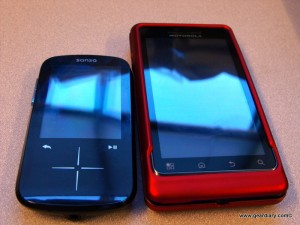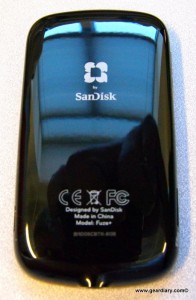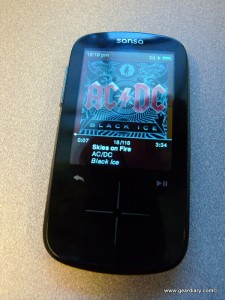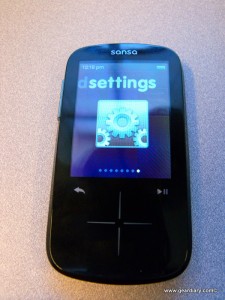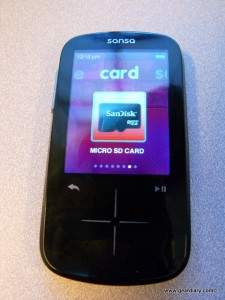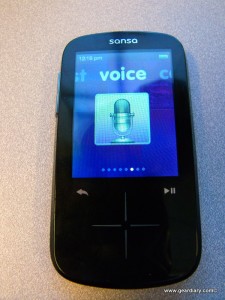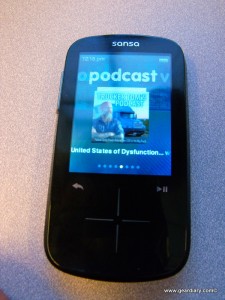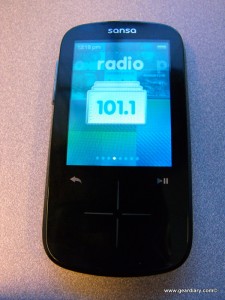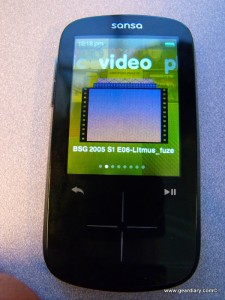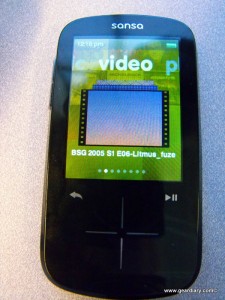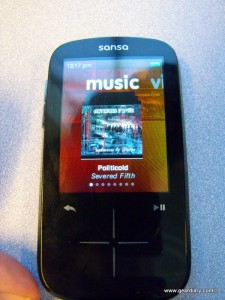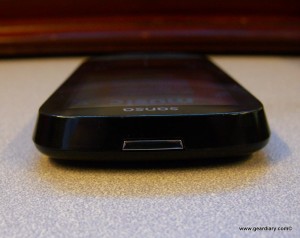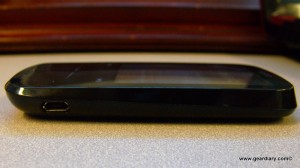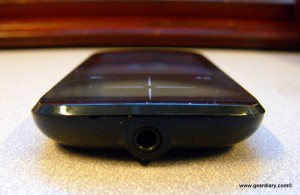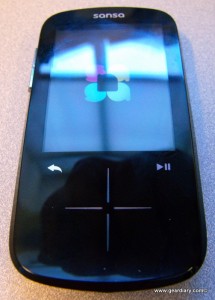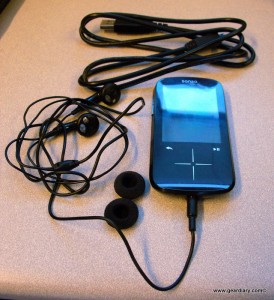
Sandisk has long produced the Fuze line of mp3 players and while they aren’t nearly as popular as Apple’s products, they do indeed have a following within certain communities. Since Sandisk has long had compatibility with open codecs such as Ogg Vorbis , the Linux and Open Source community loves them. Many of my friends have them and I purchased the last generation Fuze for my wife. I was impressed with what Sandisk had done with the device as well as with its price. Sandisk was nice enough to send me the new Fuze+ to review. Did it improve upon the older device or did it take a step backward? We’ll find out.

The Sansa Fuze+ is a Sansa Fuze in name only as they have totally revamped it’s interface and control system and hardware for this device. The device has a look that is reminiscent of the HTC myTouch3g and almost mocks the entire form factor. It even has a chin like the myTouch3g. The similarities end there as this device is many times smaller than this phone and also does not have a touch screen or the wheel that the old Fuze had. Instead, the main control is a set of touch controls with a plus sign at the center.

Files Supported
- Audio formats: MP3, WMA, Secure WMA, Ogg Vorbis, FLAC, AAC, Audible, Podcasts
- Video formats: MPEG-4***, H.264, WMV and Flip Video™***
- Photo formats: JPEG and BMP; photo formats can be further extended with Sansa Media Converter PC software download?, enabling TIFF, GIF, and PNG formats
Sandisk has blessed their Sansa line with excellent codec support. Firing up a little Severed Fifth while I am at work in the Ogg Vorbis format sounded excellent and worked well. All of my music worked on the Fuze+ with the exception of Ogg files with album art.
The Fuze+ only supports album art that is embedded into your music. So if you buy music on Amazon you are all set and the album art should just work. For your mp3’s you ripped a while back, you may want to make sure the album art is embedded if you like to see it when your listening to music. If the tool you use supports v2.3 of the id3 tag, use it. The newer 2.4 version does not seem to fully work. Ogg Vorbis encoded music usually works ok, but I did have some issues. If the Ogg had album art in it, the file would be seen by the player, but then would not work. Ogg has supported album art for quite sometime now and it would be nice if the Fuze+ did. SanDisk should update the firmware to support this.
Video is one area where you just can’t get a player that supports everything you might want. However, the video support that is included is one of the most widely used formats for Video Podcasts, h.264. I played several podcasts and a recording I had made with the Neuros OSD and it worked well. Sandisk includes a media converter that I really hated. It was just a relabeled version of a Intervideo product and you had to have your Fuze+ connected at the SAME time! I would use the open source video4fuze which is supported on Windows and Linux. If you don’t want to use the Sansa Media Converter or video4fuze, the specifics on the video format you should use are over on this post in the Sandisk forums.
Photo support is included and it supports jpg or bmp. I copied over some pics from the last year or so and was able to view the full-sized picture on the Fuze+. It was a little slow, so you may want to resize the pics. This will help keep the interface a bit faster. Although, I think, for me, that this will be a little used feature since my camera’s LCD is about the same size.
Getting Music on the Player
Sandisk ships no software with the player except for the cd containing the Rhapsody Music Service software. The player will work in 2 different modes on most Windows machines. Modes supported on Windows are MTP(Media Transfer Protocol) or MSC (Mass Storage Mode). MTP also will work with many Linux programs. MTP mode basically lets you use Windows Media Player to manage music and playlists on the device. My preference is for Mass Storage Mode as it will basically let you just drag and drop music from your hard drive to the player. If you are a Windows or Linux user and are a heavy user of playlists, I would choose MTP mode and use Windows Media Player or your favorite media player that supports MTP. You can create playlists on the device in Mass Storage mode, but it’s not something I recommend for someone coming from a iPod or Zune to this device. I am still searching for an easier way on Linux, but I am using Audacious and a Text Editor to make playlists. I won’t go into the details in this review, but it works fine for me. It definitely is not as elegant as a iPod, but it does indeed work. Mass Storage Mode is the ONLY mode supported on Mac OS X.

Using the Player
To switch from function to function, swipe your finger to the left or to right across the plus sign. Once in a function like music, you swipe up and down to flip through the artwork or thumbnail for the last 10 files played. Pressing in the middle will sort the tracks by artist first, but then you swipe right to left to change the sort to go by albums, songs, genres and playlists. There’s a similar menu for each function on the player. Functions included are music, video, photo, radio(FM Only), Podcast, Voice (for audio recording), card (for accessing the sd card) and settings.
Using it is easy enough, but there are a few little niggles I would like to address. First is the screen lock function. To lock the screen, you hold the play button until it locks. To unlock you swipe up the screen and there lies the problem. Whenever I reach into my pocket I end up unlocking the thing. Sometimes I will unlock it without even touching it! This is annoying to no end as I usually end up losing my place in the podcast I am listening to which really stinks if it’s a two-hour podcast. The only fix I see for this may be to change how you unlock it. PLEASE do this Sandisk! I would have much preferred a physical lock switch, but if a fix is made in the firmware, I can deal with it.
Also, when scrolling through the menus, sometimes the touch controls work great. Other times they don’t. This makes navigation a little frustrating. It’s not the most horrible interface I have ever used. I just don’t like the touch control near as much as I do either a touch screen or a mechanical click wheel.
The one positive thing about the interface is that it is much better looking than the old Sansa Fuze interface and looks much less like Windows 98. I like the options you have for customizing the interface. The default wallpaper will be randomized from the album art on your tracks. You can, however, take any picture and make it your wallpaper instead. Also, say you never use the FM Radio. A quick trip to the Settings menu and you will never have to see the FM Radio section when scrolling through the functions.

Podcast Listening
The Fuze+ has a podcast function. This will gather any media file with the genre tag as podcast and put them in a separate area. They can be in the Podcast folder on the device or anywhere else including the SD Card. Once nice feature is you can speed up the playing of the file without changing the tonal quality. That is, your podcast host won’t sound like a chipmunk and you finish listening to the podcast faster. The only other option in this function is a delete option.
The one feature that is SORELY missing is restarting a podcast where you left-off. Sandisk knows about this and has listed this as something they are working on for a future release.
Exterior
The Sansa Fuze+ is made out of plastic. While I had no concerns with creaks, I did already put a minor scratch in it. I guess it is to be expected with something that is only around 90 dollars. It also has a non-removable battery and no visible way to crack it open to replace the battery. I’ve been resigned to the fact that in a couple of years, Sandisk will have a new model and I’ll pick that one up since this one will probably be scratched and have a battery near deaths door.
Conclusion
I can’t say that the Sandisk Sansa Fuze+ is better than my now 5 year old iPod Video is. It’s a quality player and I do enjoy using it but there’s many little things that just takes it down a notch or two. If Sandisk resolves some of the issues I have had with the lock and resuming podcasts where they left off then I think it would be almost perfect for me. As for the rest of it, if you need a tool to help you manage the device, then the Sansa Fuze+ isn’t for you if you hate Windows Media Player. However, if you want to take control of the music yourself or you use a simpler player like Winamp or Audacious on Linux, then this is the device for you.
MSRP: $79.99 (4GB), $89.99 (8 GB), $119.99(16 GB)
What I liked: Simple drag and drop to get music on the device. The audio recording feature is nice as well.
What needs improvement: The lock function is way to easy to disable with it regularly being disabled in my pocket. This needs fixed as well as being able to restart podcasts where you left off.

